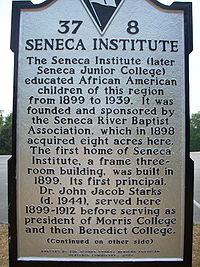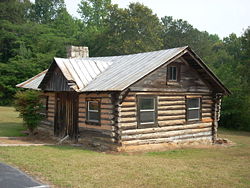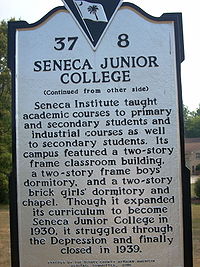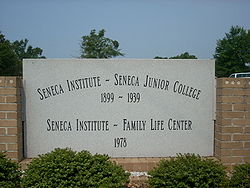
Seneca Institute - Seneca Junior College
Encyclopedia

Seneca, South Carolina
Seneca is a city in Oconee County, South Carolina, United States. The population was 7,652 at the 2000 census. It is the principal city of the Seneca Micropolitan Statistical Area Seneca is a city in Oconee County, South Carolina, United States. The population was 7,652 at the 2000 census. It is...
from 1899 to 1939. This was in a period of segregated public schools in South Carolina
South Carolina
South Carolina is a state in the Deep South of the United States that borders Georgia to the south, North Carolina to the north, and the Atlantic Ocean to the east. Originally part of the Province of Carolina, the Province of South Carolina was one of the 13 colonies that declared independence...
.
History
The Seneca Institute was a ChristianChristian
A Christian is a person who adheres to Christianity, an Abrahamic, monotheistic religion based on the life and teachings of Jesus of Nazareth as recorded in the Canonical gospels and the letters of the New Testament...
, primary and secondary school for African Americans that was founded in 1899 by the Seneca River Baptist Association. It occupied about 8 acres (3.2 ha) in Seneca, South Carolina. The site is bounded by West South Third and South Popular Streets and Scotland Road. It was founded to promote education for African-American children at a time in which there was no secondary school for African Americans in Oconee County.
The first president of the Seneca Institute was Rev. Dr. John Jacob Starks. He was born in what is now rural Greenwood County. He served the Seneca Institute for thirteen years. He left to become the president of Morris College
Morris College
Morris College , located in Sumter, South Carolina, is a four-year, coeducational, liberal arts, private, historically black college which operates under the Baptist Educational and Missionary Convention.- History :...
in Sumter, South Carolina
Sumter, South Carolina
-Demographics:, there were 59,180 people, 34,717 households, and 4,049 families living in the city. The population density was 4,469.5 people per square mile . There were 416,032 housing units at an average density of 603.0 per square mile...
. After serving as its president from 1912 to 1930, he became the president of Benedict College
Benedict College
Benedict College is a historically black, liberal arts college located in Columbia, South Carolina. Founded in 1870 by northern Baptists, it was originally a teachers' college. It has since expanded into a four-year college.-History:...
in Columbia, South Carolina
Columbia, South Carolina
Columbia is the state capital and largest city in the U.S. state of South Carolina. The population was 129,272 according to the 2010 census. Columbia is the county seat of Richland County, but a portion of the city extends into neighboring Lexington County. The city is the center of a metropolitan...
. He served as its president until his death.


Junior college
The term junior college refers to different educational institutions in different countries.-India:In India, most states provide schooling through 12th grade...
and teaching training course.
The school struggled during the Great Depression
Great Depression
The Great Depression was a severe worldwide economic depression in the decade preceding World War II. The timing of the Great Depression varied across nations, but in most countries it started in about 1929 and lasted until the late 1930s or early 1940s...
. It was closed in 1939.
The Seneca Institute had students who lived in the community and boarders. It had a brick dormitory for girls, the B.S. Sharp Dormitory for boys, the A.P. Dunbar Hall for classes, and a library. Except for the log cabin library that is still standing, the buildings were razed in 1963.
Other African-American Schools
During the period of segregated education, there were other private and public schools in Oconee County. The Norrel School was found by Northern Presbyterians. It began as a church and school on Fairplay Street in front of Mt. View Cemetery. The school closed prior to 1939.The Oconee County Training School, which was a teaching training school for African Americans, was a public institution founded in 1925. Its programs included home economics, industrial arts, and agriculture. In 1955, its building was used for East End Elementary School.
Blue Ridge High School was built in 1955 to serve the African-American community. It continued as the African-American high school in the Seneca area until 1969 when the county public schools were integrated. The building was renamed Seneca Junior High School and later Code Elementary School.
Legacy

In 1978, the Seneca River Improvement Association dedicated the Seneca Institute Family Life Center, a multi-purpose building, as a community center. It is located on the old campus of the Seneca Institute - Seneca Junior College.

